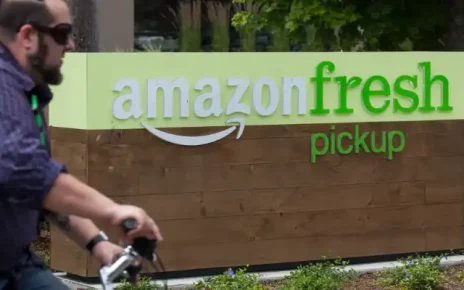Seattle is a famous city with a tremendous culinary industry and leading technological innovation. However, Seattle has recently become the site of food delivery service upheaval. This disruption has caused some bitterness among people who are pushing the city council to intervene and address concerns about its impact on local businesses and workers.

The Rise of the Food Aggregators: A Double-Edged Sword
In recent years, there has been an explosion in the number of food delivery services due to the convenience they offer to time-poor consumers. Today, DoorDash, Grubhub, or Uber Eats are synonymous with ordering from your favorite restaurant in a matter of clicks. This shift indeed transformed the face of the food industry, affecting both local economies and consumer behavior.
These major players in the food delivery market act as aggregators, linking up restaurants with customers by taking care of delivery logistics. While this makes it very convenient for consumers, it raises concerns over the charges leveled by such platforms, which can highly cut into restaurant profits. Moreover, the proliferation of app-based food delivery services contributes to what’s known as the “gig economy,” whereby independent contractors deliver meals on their schedule. Although this brings flexibility to drivers, it tends to be accompanied by insecurity among employees since they lack job security and benefits.
The Seattle Shakeup: A Recipe Gone Wrong?
So what exactly pulled off this shakeup in Seattle’s food delivery? Depending on whom you ask, specifics might vary, but several factors have contributed to the current situation:
- Increased Competition: The Seattle market is overcrowded with various apps that operate within it, offering fierce competition for restaurant partnerships.
- Rising Fees: These apps charge high commissions per order made through them, hence making things rougher for these smaller or mid-sized outlets trying hard to stay profitable.
- Delivery Worker Concerns: Workers’ issues around pay rates, working conditions, and access to basic benefits have also come up, questioning the fairness of this system.
These factors have had a ripple effect, affecting local restaurants, delivery workers, and consumers alike. There has been a drop in profits for some restaurants due to high platform fees. Low wages and job insecurity are some of the issues that delivery drivers have decried. Finally, with more players on board, customers may face higher costs for their deliveries.
Statistics reveal something disturbing. According to a recent study by the Seattle City Council, it is estimated that the average commission rate paid by restaurants in Seattle is around 30% to food delivery companies. A survey of delivery persons also established that many earn below the minimum wage after all expenses have been deducted.
The City Council Steps Up to the Plate: Seeking Solutions
The Seattle City Council has seen the implications that might arise from such a food delivery shakeup and has therefore decided to take measures towards addressing some grievances. Here are some strategies that they can consider:
- Capping Commission Fees: The city council may place limits on the amount of commission charges that can be made by food delivery platforms to restaurants. So far, such action would make it possible for eateries to remain viable while providing them with home deliveries.
- Improving Worker Standards: Delivery workers could benefit from regulations such as better working conditions through fair pay and basic benefits provisions like other professions do.
- Promotion of Transparency: The industry of food delivery is moving towards greater transparency so that restaurants and even clients can make informed choices.
Alarm Bells Ring at City Hall: Seattle City Council Airs Concerns
The Seattle City Council has not been shy in expressing their worries about the shakeup in food delivery. Here are some of their concerns:
- Workers’ Dignity: The council is concerned about possible exploitation, for example, low wages, poor working conditions, and no access to basic benefits for these delivery people.
- Influence on Local Traders: There is anxiety that smaller independent restaurants, which are already struggling with demands and fees associated with delivery platforms, could be disproportionately affected by this kind of upheaval.
- Safeguarding Consumers: Issues relating to dish quality safety, data privacy, and potential price gouging remain uncertain when it comes to food bought via such channels.
These problems have far-reaching consequences. If workers feel stressed or undervalued, they may resign more frequently, resulting in a deterioration of service standards. Small businesses, often considered the backbone of Seattle’s culinary scene, might be forced to close shop, thereby stifling innovation and diversity. Lastly, consumers will probably pay more for inferior meals as they experience a growing sense of insecurity over their personal information being used without permission.
Among other things, the city council is considering toughening rules governing delivery platforms, minimum wage legislation for drivers, and data-sharing arrangements that allow customers to compare prices transparently.
Voices from the Grapevine: Stakeholders’ Perspectives
In our examination of what followed after Seattle’s latest food delivery shake-up, this paper thus seeks to highlight the different viewpoints held by key actors—restaurant owners, delivery personnel, and end users—whose voices from trenches reveal how complex the industry is.
A- Restaurant Owners
Local eatery operators talk differently about this. Some find these online services useful as they help to widen their customer base, while others complain of high commissions that are not affordable and a loss of control over the food quality delivered.
B- Delivery People
Delivery people have different experiences. While some prefer app-based delivery jobs because they offer flexibility, others have a hard time adjusting to the irregularity of their routines, fluctuating earnings, and lack of access to conveniences like toilets during work.
C- Consumers
The main advantage that consumers see in these services is convenience. However, people are worried about costs in the case of delivery, as well as hidden charges and doubts about what will come inside the package and when it will be warm enough.
Beyond the Plate: Potential Impacts on the Community
This food delivery shake-up could have far-reaching effects beyond each order. Here’s a closer look:
- Deepening Inequity: There is an argument that these changes may hurt poor neighborhoods, which cannot afford healthy foods every day. Also, existing economic disparities may worsen if these kinds of orders are exploited by deliverers excessively.
- The Future of Local Businesses: This raises concerns among experts about whether independent restaurants might survive under such circumstances given the market dominance of major online food vendors and also if they become standardized in terms of offerings, thereby forcing customers into limited options.
The Role of Local Government: Mitigating Impacts and Fostering Change
Local government has an important role that it can play in navigating this complicated landscape. Here are some ways they can help:
- Promoting Equal Opportunities: The local set-up should introduce legislation aimed at ensuring equal treatment for deliverers and fair competition with small businesses involved in this sector.
- Supporting Innovation: There are initiatives that can be formulated to stimulate inventive and sustainable delivery models that give priority to staff health and safety, as well as the impact on nature.
- Empowering Consumers: Through widespread educational campaigns, consumers would be educated about their rights and the choices they have when it comes to food delivery services; hence, making informed decisions.
Conclusion
The recent shakeup in Seattle’s food delivery scene raises valid concerns about worker rights, fair business practices, and the overall impact on the community. By addressing City Council anxieties, recognizing stakeholder views, and taking steps towards reducing adverse effects through active engagement in mitigation measures, local authorities can turn this transition period into a win-win situation for all parties involved within a food delivery chain.
This is crucial for all of us who are concerned citizens as well as users of these services so that we may know what happens next and also help create an ethical framework for food delivery systems that promote equity among various communities along with the preservation of natural resources.




